高中英语 Unit1 (Project 第1部分)教案 译林牛津版必
- 格式:doc
- 大小:132.01 KB
- 文档页数:6
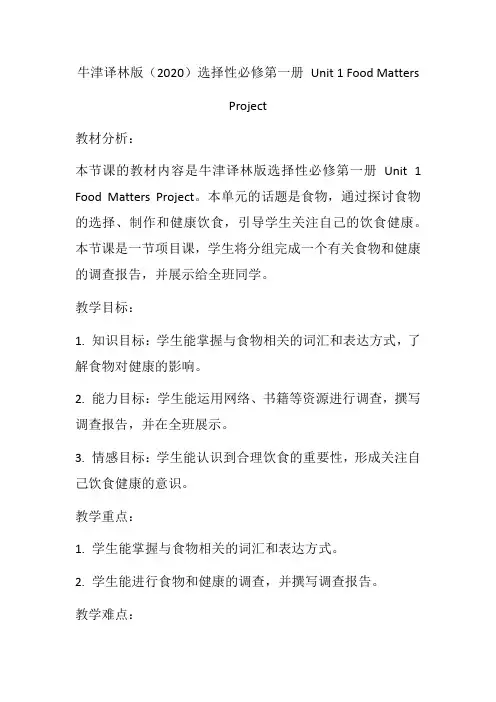
牛津译林版(2020)选择性必修第一册Unit 1 Food MattersProject教材分析:本节课的教材内容是牛津译林版选择性必修第一册Unit 1 Food Matters Project。
本单元的话题是食物,通过探讨食物的选择、制作和健康饮食,引导学生关注自己的饮食健康。
本节课是一节项目课,学生将分组完成一个有关食物和健康的调查报告,并展示给全班同学。
教学目标:1. 知识目标:学生能掌握与食物相关的词汇和表达方式,了解食物对健康的影响。
2. 能力目标:学生能运用网络、书籍等资源进行调查,撰写调查报告,并在全班展示。
3. 情感目标:学生能认识到合理饮食的重要性,形成关注自己饮食健康的意识。
教学重点:1. 学生能掌握与食物相关的词汇和表达方式。
2. 学生能进行食物和健康的调查,并撰写调查报告。
教学难点:1. 学生能正确使用网络和书籍等资源进行调查。
2. 学生能将所学的知识与实际生活相结合,关注自己的饮食健康。
学情分析:高一学生已经具备一定的英语基础,能够进行简单的阅读、写作和口语交流。
同时,学生对食物和健康的话题比较熟悉,也具备一定的生活经验和知识储备。
但是,学生在进行调查和报告展示方面可能存在一定的困难,需要教师的指导和帮助。
教学策略:1. 教师可以提供一些与食物和健康相关的词汇和表达方式,帮助学生掌握相关知识点。
2. 教师可以引导学生利用网络、书籍等资源进行调查,并给予一定的指导和帮助。
3. 教师可以组织学生进行小组讨论和展示活动,鼓励学生积极参与并互相学习。
教学方法:1. 词汇和表达方式讲解:教师可以利用课件、图片等方式展示与食物和健康相关的词汇和表达方式,帮助学生掌握相关知识点。
2. 调查和报告撰写:学生可以分组进行调查,撰写调查报告。
教师可以给予一定的指导和帮助,引导学生利用网络、书籍等资源获取相关信息。
3. 小组讨论和展示:教师可以组织学生进行小组讨论和展示活动,鼓励学生积极参与并互相学习。

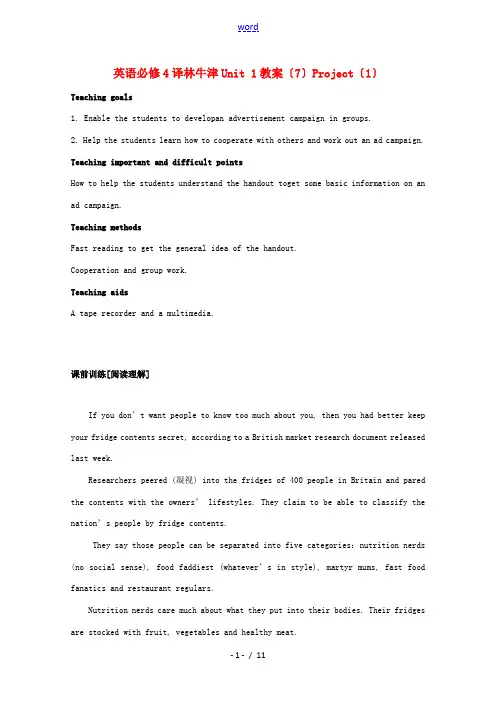
英语必修4译林牛津Unit 1教案〔7〕Project〔1〕Teaching goals1. Enable the students to developan advertisement campaign in groups.2. Help the students learn how to cooperate with others and work out an ad campaign. Teaching important and difficult pointsHow to help the students understand the handout toget some basic information on an ad campaign.Teaching methodsFast reading to get the general idea of the handout.Cooperation and group work.Teaching aidsA tape recorder and a multimedia.课前训练[阅读理解]If you d on’t want people to know too much about you, then you had better keep your fridge contents secret, according to a British market research document released last week.Researchers peered (凝视) into the fridges of 400 people in Britain and pared the contents with the owners’ lifestyles. They claim to be able to classify the nation’s people by fridge contents.They say those people can be separated into five categories:nutrition nerds (no social sense), food faddiest (whatever’s in style), martyr mums, fast fo od fanatics and restaurant regulars.Nutrition nerds care much about what they put into their bodies. Their fridges are stocked with fruit, vegetables and healthy meat.People in this category tend to be highly organized and usually work in law or accountancy. The vast majority is single, but if they have a partner, that person will be similar.A fridge full of vitamins — enriched juices implies its owner works in media or fashion. They tend not to eat the foods they buy. Known as the food faddiest, they just want to be seen as purchasing the latest important things.A fridge filled with everything from steak to frozen fish suggests the martyr mum. Her fridge tends to be stocked with every kind of product, except what she herself would want. This fridge hints at difficulty balancing family and work life.Fast food fanatics always buy mineral water or soda pop. The nearest they will get to fresh fruit is tomato sauce. Their fridges hint at someone who works hard and plays hard, also, someone who is not into long term planning.Finally, a fridge filled with nothing more than a bottle of white wine and some sparkling mineral water implies an owner who is single, lives in a big city and enjoys the finer things in life. The fridge is empty because this person regularly eats in restaurants.36. What can we know from the first two paragraphs?A. Some researchers are fond of staring at other people’s fridges.B. People don’t want others to know about their secrets.C. The food you put in the fridge has something to do with your personality.D. There are mainly five kinds of lifestyles among British people.[答案]C[解析]细节理解题。
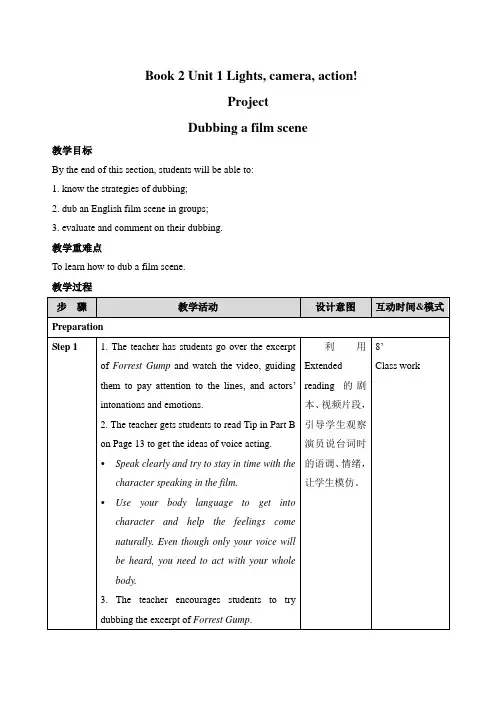
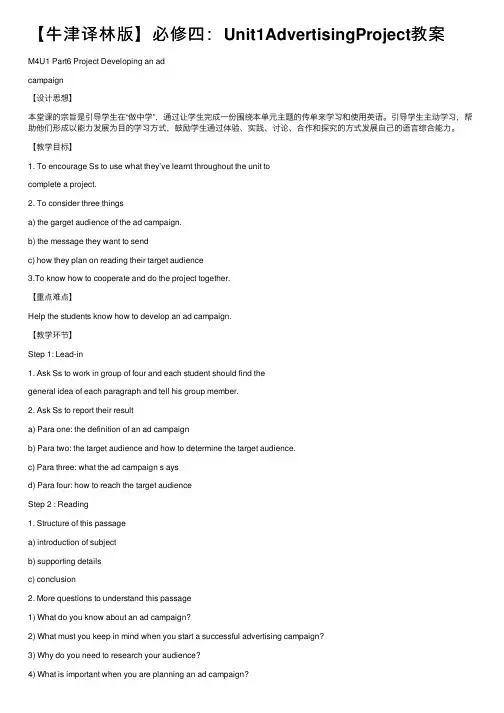
【⽜津译林版】必修四:Unit1AdvertisingProject教案M4U1 Part6 Project Developing an adcampaign【设计思想】本堂课的宗旨是引导学⽣在“做中学”,通过让学⽣完成⼀份围绕本单元主题的传单来学习和使⽤英语。
引导学⽣主动学习,帮助他们形成以能⼒发展为⽬的学习⽅式,⿎励学⽣通过体验、实践、讨论、合作和探究的⽅式发展⾃⼰的语⾔综合能⼒。
【教学⽬标】1. To encourage Ss to use what they’ve learnt throughout the unit tocomplete a project.2. To consider three thingsa) the garget audience of the ad campaign.b) the message they want to sendc) how they plan on reading their target audience3.To know how to cooperate and do the project together.【重点难点】Help the students know how to develop an ad campaign.【教学环节】Step 1: Lead-in1. Ask Ss to work in group of four and each student should find thegeneral idea of each paragraph and tell his group member.2. Ask Ss to report their resulta) Para one: the definition of an ad campaignb) Para two: the target audience and how to determine the target audience.c) Para three: what the ad campaign s aysd) Para four: how to reach the target audienceStep 2 : Reading1. Structure of this passagea) introduction of subjectb) supporting detailsc) conclusion2. More questions to understand this passage1) What do you know about an ad campaign?2) What must you keep in mind when you start a successful advertising campaign?3) Why do you need to research your audience?4) What is important when you are planning an ad campaign?5) What should your advertising campaign be based on?3. Use the same way to read the other article. Following questions will help you to understand it bette r.1)Why is anti-smo king chosen as the subject of the ad campaign?2)What is the main aim of the anti-smoking campaign?3)How can high-school teenagers be convinced not to start smoking? Step 3: Language focus:Step 4:Developing an ad campaignPlanningPreparingProducingPresentingStep 5:Homework语⾔点(供参考,可根据学⽣情况进⾏删减)1. build—built---buil t①建⽴,创⽴: build a nation 建⽴⼀个国家built a successful business out of their corner grocery store. 从他们街道拐⾓的杂货店创办了⼀家成功的公司②监督:命令、资助或监督…的建设:The administration built several new housing projects.⾏政部门资助了好⼏幢新楼的建筑项⽬We are building socialism with the Chinese characters.2. reach①被看到/听到Through television and radio we are able to reach a wider audience.②伸展,伸出,延伸:reached out an arm.伸出⼀只⼿臂③到达 I hope this little will reach you.3.have …. in mind考虑When you’re going to do sth. you must have a clear target in mind. Watching TV all evening wasn’t exactly what I had in mind.have it in mind to do sth… 打算做某事You must have it in mind to post the letter for me.keep /bear … in mind 记住= learn by heartmake up one’s mind/change one’s mind 下定决⼼/改变主意4. figure out①理解,弄明⽩I can’t figure out why he quit his job.②想出,计算出 Have you figure out how much the holiday will cost?He's trying to figure out a way to solve the problem.5. get … to do 使…做某事He got his sister to help with his homework.get … doing 使…开始做某事Can you really get the old car running again?What he said got me th inking.get … done 使…被做I got my pocket picked the other day.get done 表被动get hurt/burnt/separated6. determine v.确定;决定Vt.确定 determine sth.They have determined the date for our party.Vi.决定determine to do sth.= be determined to do sth. 下定决⼼做He determined to get there first.= He was determined to get there first.determine on (doing )sth. 就……做出决定We determined on an early start.adj. determined 有决⼼的,决定的(在句中常作定语或状语)She is a very determined woman who always gets what she wants.be determined +从句/be determined to do sth.At the age of twenty, Steve left his hometown, determined not to return without making his mark. 在⼆⼗岁时,Steve离开了他的家乡,下定决⼼不搞出点名堂绝不回来。

《英语》(选择性必修·第一册)Unit 1 Food mattersIntegrated skills (II)I. Learning objectivesBy the end of the lesson, students will be able to:1. talk about their favorite food, including its appearance, smell, taste, ways of cooking and a particular experience associated with it;2. write an article about their favorite food.II. Key competence focusWrite an article about their favorite food.III. Predicted area of difficulty1. How to convey the ideas clearly.2. How to write an article vividly.IV. Teaching proceduresStep 1 Lead-in1.T presents some pictures of food such as mooncake, Tiramisu, dumpling, hot pot, etc. and asks the following questions:Picture 1 (Mooncake)T: What can you see in the picture?S: Mooncakes.T: Have you tried a mooncake?S: Yes.T: When did you try it for the first time?S: I gave it my first try at the age of 5.T: Do you like it?S: Yes, very much.T: How does it taste?S: It tastes sweet.Picture 2 (Tiramisu)T: Do you know the dessert in the picture?S: It is Tiramisu.T: How does it look?S: It looks adorable.Picture 3 (Dumpling)T: What’s the picture about?S: Dumplings.T: Do you know how to cook the dish?S: It can be steamed, boiled or fried.Picture 4 (Hot pot)T: What’s it?S: It’s a hot pot.T: How do you think it feels in your mouth?S: I think it is spicy.2. T asks more questions as follows:T: What’s your favorite food? Why do you like it?(Ss may give various answers.)3. T shows a picture of salted duck and mentions her experience of tasting it for the first time.T: Salted duck is one of my personal favorites. I gave it my first try twenty years ago, together with my family members. My father went on a business trip to Nanjing and brought one back. Itlooked mouth-watering. Before my mother sliced it, brother and I couldn’t wait to have a try. The meat was juicy and salty, which really impressed all of us. How can I forget such a tasty dish?【设计意图:通过互动,引入主题,并为对话环节做铺垫。

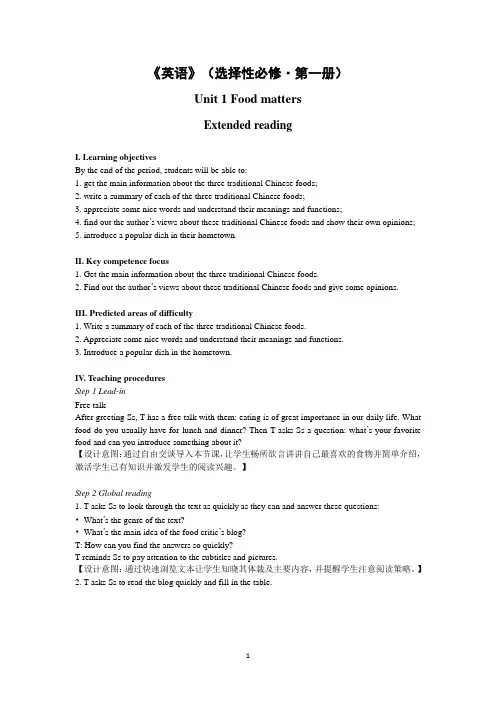
《英语》(选择性必修·第一册)Unit 1 Food mattersExtended readingI. Learning objectivesBy the end of the period, students will be able to:1. get the main information about the three traditional Chinese foods;2. write a summary of each of the three traditional Chinese foods;3. appreciate some nice words and understand their meanings and functions;4. find out the author’s views about these traditional Chinese foods and show their own opinions;5. introduce a popular dish in their hometown.II. Key competence focus1. Get the main information about the three traditional Chinese foods.2. Find out the author’s views about these traditional Chinese foods and give some opinions.III. Predicted areas of difficulty1. Write a summary of each of the three traditional Chinese foods.2. Appreciate some nice words and understand their meanings and functions.3. Introduce a popular dish in the hometown.IV. Teaching proceduresStep 1 Lead-inFree talkAfter greeting Ss, T has a free talk with them: eating is of great importance in our daily life. What food do you usually have for lunch and dinner? Then T asks Ss a question: what’s your favorite food and can you introduce something about it?【设计意图:通过自由交谈导入本节课,让学生畅所欲言讲讲自己最喜欢的食物并简单介绍,激活学生已有知识并激发学生的阅读兴趣。
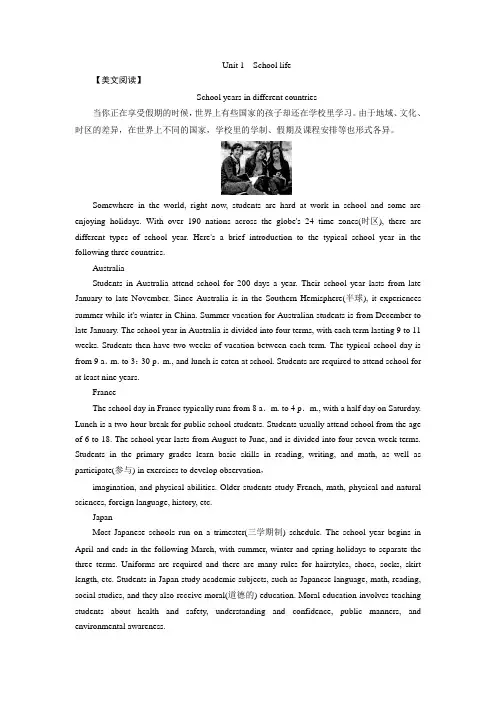
Unit 1School life【美文阅读】School years in different countries当你正在享受假期的时候,世界上有些国家的孩子却还在学校里学习。
由于地域、文化、时区的差异,在世界上不同的国家,学校里的学制、假期及课程安排等也形式各异。
Somewhere in the world, right now, students are hard at work in school and some are enjoying holidays. With over 190 nations across the globe's 24 time zones(时区), there are different types of school year. Here's a brief introduction to the typical school year in the following three countries.AustraliaStudents in Australia attend school for 200 days a year. Their school year lasts from late January to late November. Since Australia is in the Southern Hemisphere(半球), it experiences summer while it's winter in China. Summer vacation for Australian students is from December to late January. The school year in Australia is divided into four terms, with each term lasting 9 to 11 weeks. Students then have two weeks of vacation between each term. The typical school day is from 9 a.m. to 3:30 p.m., and lunch is eaten at school. Students are required to attend school for at least nine years.FranceThe school day in France typically runs from 8 a.m. to 4 p.m., with a half day on Saturday. Lunch is a two-hour break for public school students. Students usually attend school from the age of 6 to 18. The school year lasts from August to June, and is divided into four seven-week terms. Students in the primary grades learn basic skills in reading, writing, and math, as well as participate(参与) in exercises to develop observation,imagination, and physical abilities. Older students study French, math, physical and natural sciences, foreign language, history, etc.JapanMost Japanese schools run on a trimester(三学期制) schedule. The school year begins in April and ends in the following March, with summer, winter and spring holidays to separate the three terms. Uniforms are required and there are many rules for hairstyles, shoes, socks, skirt length, etc. Students in Japan study academic subjects, such as Japanese language, math, reading, social studies, and they also receive moral(道德的) education. Moral education involves teaching students about health and safety, understanding and confidence, public manners, and environmental awareness.From:http://www.factmonster. com【诱思导学】1.What is the difference between our school year and theirs?【答案】We have different terms. There are usually two terms in our school year while in both Australia and France, they have four terms and Japan has three.2.Do you think our present school year is good or not, and why?【答案】It is hard to say good or bad because different countries lie in different time zones, they enjoy different holidays and different schools.3.Do you want to know the school life in the UK?Why or why not?【答案】Yes. Because the school life in the UK interests me very much./No. Because I have no interest in the school life there. It's none of my business.Period ⅠPreviewing(教师用书独具)●教学目标本课时主要是通过学生对学案所给出的内容的学习,了解本课文中所出现的词汇,初步了解课文以及相关的背景知识,对下一堂课课文的全面理解起到一个铺垫作用。
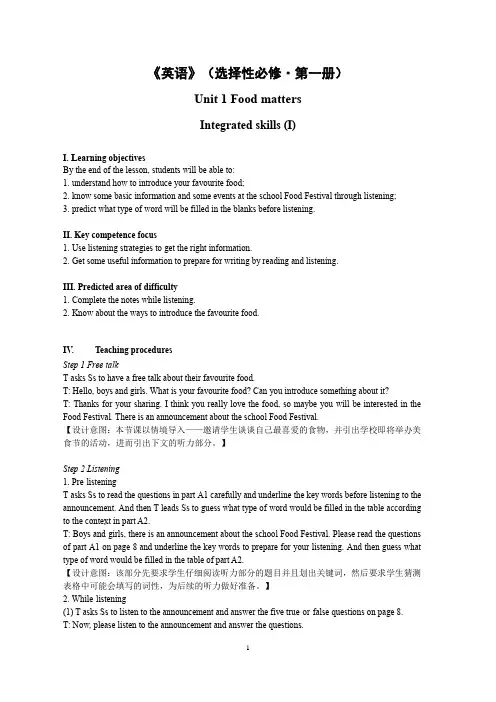
《英语》(选择性必修·第一册)Unit 1 Food mattersIntegrated skills (I)I. L earning objectivesBy the end of the lesson, students will be able to:1. understand how to introduce your favourite food;2. know some basic information and some events at the school Food Festival through listening;3. predict what type of word will be filled in the blanks before listening.II. Key competence focus1. Use listening strategies to get the right information.2. Get some useful information to prepare for writing by reading and listening.III. Predicted area of difficulty1. Complete the notes while listening.2. Know about the ways to introduce the favourite food.IV. Teaching proceduresStep 1 Free talkT asks Ss to have a free talk about their favourite food.T: Hello, boys and girls. What is your favourite food? Can you introduce something about it?T: Thanks for your sharing. I think you really love the food, so maybe you will be interested in the Food Festival. There is an announcement about the school Food Festival.【设计意图:本节课以情境导入——邀请学生谈谈自己最喜爱的食物,并引出学校即将举办美食节的活动,进而引出下文的听力部分。
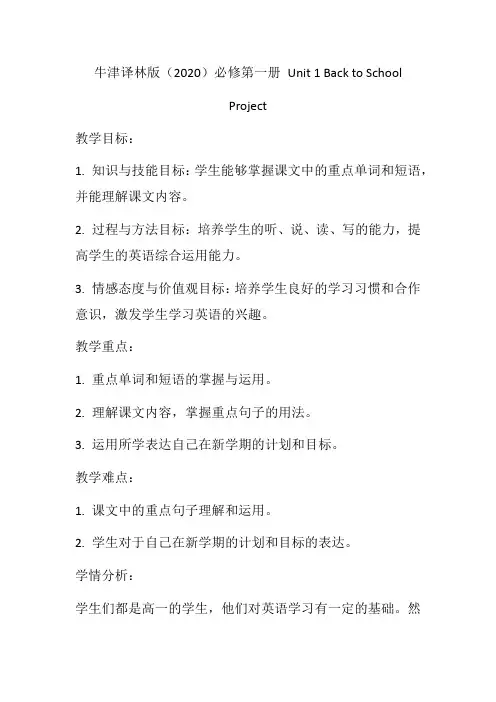
牛津译林版(2020)必修第一册Unit 1 Back to SchoolProject教学目标:1. 知识与技能目标:学生能够掌握课文中的重点单词和短语,并能理解课文内容。
2. 过程与方法目标:培养学生的听、说、读、写的能力,提高学生的英语综合运用能力。
3. 情感态度与价值观目标:培养学生良好的学习习惯和合作意识,激发学生学习英语的兴趣。
教学重点:1. 重点单词和短语的掌握与运用。
2. 理解课文内容,掌握重点句子的用法。
3. 运用所学表达自己在新学期的计划和目标。
教学难点:1. 课文中的重点句子理解和运用。
2. 学生对于自己在新学期的计划和目标的表达。
学情分析:学生们都是高一的学生,他们对英语学习有一定的基础。
然而,他们可能对新学期的计划和目标有一些困惑,也许还不太清楚如何用英语表达。
因此,在教学过程中,需要关注学生的积极性和参与度,并提供适当的指导和帮助。
教学策略:1. 激发学生的学习兴趣:通过设计生动有趣的教学活动,激发学生学习英语的兴趣。
2. 提供合作学习机会:让学生进行小组活动或合作讨论,培养合作意识,促进学生之间的互相帮助和学习。
3. 引导学生自主学习:鼓励学生积极参与课堂活动,培养他们的自主学习能力。
教学方法:1. 预习导入法:通过呈现一张学生在新学期的计划表,向学生介绍课文主题,引起学生对话题的兴趣。
2. 情景教学法:通过提供一个情境,让学生在情景中使用所学单词和短语,巩固词汇的理解和运用。
3. 互动式教学法:通过问答、小组讨论等方式,让学生积极参与课堂教学活动,提高学生的语言运用能力。
总结:本节课教学旨在帮助学生通过学习课文并进行相关活动,掌握课文中的重点单词、短语和句子的用法,培养学生的听、说、读、写的能力,同时激发学生对学习英语的兴趣,培养他们良好的学习习惯和合作意识。
通过预习导入法、情景教学法和互动式教学法,进行教学活动,提高学生的语言综合运用能力。
导入环节(约5分钟):导入环节的目的是引起学生的注意,激发学习兴趣,并与学生建立起联系。
单元:Unit 1 The world of our senses板块:Project课堂设计指导思想:本节课是以听、说、读、写为主的project教学课。
本板块的教学以文章阅读为铺垫,重在完成计划、准备、写作,呈现的任务。
而素材的搜集范围,文章的结构,呈现的方式都可以参考阅读的内容。
因此做好阅读疏导和任务安排对最后的成果呈现是否成功有至关重要的作用。
本板块第一教时主要解决文章的理解和疏通,和任务的安排;第二课时需在几天之后进行成果汇报,提倡学生用多种方式,如海报,模拟电视播报,角色扮演小品,记者招待会等。
Teaching aims:1. Get to know something about sharks and pigeons.2. Learn to follow the structure of each passage.3. Group work: Four student s a group. Choose an animal and write a passage about it then produce a TV show.Teaching procedures:Period OneStep 1. Introduction (ppt 4-9)M any animals are of great help to our daily lives or make great contributions to the development of science and technology. Can you list some of the m?Animals are friends of human beings. However, some animals will cause trouble or danger to us in some situations. For example, when they are hungry or when they feel themselves in danger. Do you know some dangerous animals on the land? (Some pictures are shown.) There are also some dangerous animals in the water. (Some pictures are shown.)【设计说明】教师通过两段动物和人的关系的语言和相关图片分别引出本文主角鸽子和鲨鱼。
英语必修2译林牛津版Unit 1教案12(Project)Period Twelve ProjectⅠ.Teaching goals:Enable students to tell a mysterious story.Ⅱ.Teaching impo rtant & difficult points:Help students learn how to work together and tell a good story.Ⅲ.Teaching methods:Cooperation and task-based activity.Ⅳ.Teaching aids:A computer and some pictures.教师高考英语知识运用(两节,共45分)第一节:语法和词汇知识(共15小题;每小题1分,满分15分)1.S he’s got the job because she has the advantage _____others of knowing manylanguages.A.overB. aboveC. againstD. beyond2.Thank you for sending us ______ fresh vegetables of many kinds. You have done us_____ great service.A./; aB. the; aC. /;/ D the; /3. ________scores of times, but Derek still couldn’t understand how to use past participle in a concrete situation.A. Having explainedB. Having been explainedC. Though it was explainedD. It was explained4. Chinese President Hu Jintao called for an immediate cease-fire in Libya ______ an even worse humanitarian crisis in the country at the BRICS Summit in Hainan province.A. to preventB. to have preventedC. preventingD. having prevented5. –Do you think that the 16th Asian Games were a success?--Yes, _______!It couldn’t be better.A. relativelyB. approximatelyC. absolutelyD. fortunately6. –Is there an express to Beijing tonight?-- There ______be , but you’d better call the booking office to make sure.’A. canB. mightC. willD. must7. Anyway, that evening, ______ I’ll tell you more about later, I ended u p staying at Rachel’s place.A. whenB. whereC. whatD. which8. If we can ______ our present difficulties, then everything should be all right.A. come acrossB. get overC. come overD. get off9. Stella was disappointed to find her new plan ______and fell into great depression.A. put awayB. carried outC. turned downD. left out10. The black box is a necessary device on an airplane, which records its speed,direction and whether everything on the airplane______ normally.A. will functionB. functionedC. is functioningD. has functioned11. According to our principal, all children should be encouraged to realize their full_______.A. consequenceB. entertainmentC. presentationD. potential12. – Which color do you prefer, red or black?-- Red. For red _____ a sense of energy and strength.A. deliversB. conveysC. contributesD. concentrates13. It is uncertain ______ side effects these weight-loss drugs will bring about,although hundreds of thousands of patients have taken it.A. thatB. whetherC. howD. what14. ---Is there anything else I can do for you, Jack?--- No, thanks. I really appreciate ______ when you lent all your notes to me before the exam.A. thatB. oneC. itD. the one15. At the sight of the policeman _____from behind the door.A. did the boy rushed outB. rushing out was the boyC. out rushed the boyD. the boy was rushing outⅤ.Teaching procedures:Step 1 ReadingT: Have you ever heard of Yetis? Many people are said to have seen Yetis in some remote areas of the world. Do you believe it? What would you do if you came across a Yeti in the mountains? You may have a discussion first.Ss:…T: Good. Her e is a chance for you to read more about Yetis and many details in the text may inte rest you.1. Ask the students to listen to the recorder, while listening, read after the tape as fluently as possible. Then answer the following questions:Q1: In which year were Yetis seen?Q2: Where have Yetis o r similar creatures been seen?Q3: What has been reported about Yetis?2. Ask the students to discuss the answers among themselves, and then check the answers.Key1: In 1998.Key2: Yetis have been seen on the Chinese side of the Himalayas and in the Shennongjia National Forest Park in western Hubei Province.Key3: Large, hairy-black fur, 6 feet tall, huge shoulders, long arm, large hands, 33 centimeter s in length,move with amazing speed and strength, walk like a man, attack people. (key words)3. Ask the students to read the passage by themselves in detail, and then give a brief analysis of the structure and the general idea of each paragraph.Para 1 Reports about seeing Yetis in the Himalayas for hundreds of years.Para 2-4 Witnesses gave similar descriptions of Yetis and reports about Bigfoot and Wildman ofShennongjia .Para5 An American scientist’s opion.Para 7 Scientists hope the mystery will be solved one day.4.Try to distinguish the writing features of a mysterious story so that Ss may know how to write sucha story.A. an interesting and attractive titleB. an attractive beginningC. some details of the story with some pictu res or photosD. what scientists or people think about the storyE. an open end of the storyStep pare the two articles5.Ss may also consult the story Boy missing, police puzzled,which is a news story, while Searching for the Yeti is an overview about Yetis.Compare the two articles.The former one is a newspaper report.So after reading the first paragraph readers will know wha t has happened and when and where it happened and more details and information are given in the following paragraphs.The latter one is a magazine article.It is an overview with general information about Yetis.So it tells readers some details about Yetis pe ople have seen in different places.Step 3. Telling a mysterious storyTo conduct this project.Ss need to follow the following four steps:planning,preparing,producing and presenting.I’d like to give you some guide for each step:1.At the step of planning,you should first make clear the deadline is the end of this week.Then work in small groups to discuss first what to write and then the questions in this part.Divide up the work and decide what each group member will do.2. When preparing,you meet,discuss and choose from the information each group member has collected.0ne of you in the group write the outline according to the result of the discussion.When finished,the outline should be approved by the whole group.3.The next step is producing. Each of y ou should write a part of the story. Then put what you have written together. Check the story to correct mistakes if there are any. New ideas can be added. Those who are responsible for illustrating the story should draw your picture according to the writing. Then the whole group should approve the story and the illustrations.4.Then comes your time of presenting. The storyteller of each group is to tell your story to the whole class. Then put up your stories on the walls of the classroom.Step 4 HomeworkIn the next class, the storyteller of each group is to tell your story to the whole class.Record after teaching。
《英语》(选择性必修·第一册)Unit 1 Food mattersProjectI. Learning objectivesBy the end of the lesson, students will be able to:1. know about some dishes around the world;2. research reliable information and write a recipe for the chosen dish;3. make a dish and present the process to the class;4. cooperate better with group members and enjoy the process of making a dish creatively.II. Key competence focusWrite a recipe using specific language and following the given format.III. Predicted areas of difficultyCooperate with group members and finish the dish together.IV. Teaching proceduresStep 1 Lead-in1. Free talkT asks Ss to brainstorm some dishes by asking the following questions:● What do you have for breakfast/lunch/dinner?● What is your favourite dish?● Do you know how to make it?● Do you want create some new dishes?2. Task assignmentT: The school English club will hold a Food Festival, and we are invited to make a dish. So, in this class we’ll learn how to write a recipe and make a dish.【设计意图:教师通过聊天的形式引导学生说出自己喜欢的菜肴,激活学生已有知识,快速进入本堂课的主题。
英语必修4译林牛津Unit 1精品学案(Project 第1部分)教材:牛津高中英语(模块四)高一下学期文档内容:教学设计—教案单元:Unit 1 Advertising板块:Project 1课堂设计指导思想:本堂课的宗旨是引导学生在“做中学”,通过让学生完成一份围绕本单元主题的传单来学习和使用英语。
引导学生主动学习,帮助他们形成以能力发展为目的学习方式,鼓励学生通过体验、实践、讨论、合作和探究的方式发展自己的语言综合能力。
Teaching aims:1. Get to learn and use English by doing a project.2. Try to fully understand the two reading materi als and master the language items.3. Learn to get enough information about ad campaigns from the reading materials.Teaching procedures:Step 1 Lead-inShow students two groups of pictures and draw their attention to the importance of ads.【设计说明】通过两组图片将学生的思绪带回本单元主题,重新引发他们对广告的注意力,以旧带新,自然导入本课。
Step 2 Listen and understandHave students listen to the recording of the handout and answer the three questions to get a general idea of this reading material.【设计说明】帮助学生通过听录音和回答问题初步理解阅读材料,并获取有关广告宣传单的基本信息。
Step 3 Reading for detailed informationAsk students to read the material again carefully to get detailed information about developing an ad campaign.【设计说明】引导学生通过详读阅读材料,更好地理解文章并了解策划广告宣传活动的主要环节。
Step 4 Main idea of each paragraphAsk students to work in pairs to focus on each paragraph of the handout and then report the main idea of each paragraph to the class.【设计说明】启发学生注意文章的段落结构,复习说明文的阅读策略,为策划宣传单做准备,同时培养学生的合作学习能力。
Step 5 Read and understandAsk students to read the sample ad campaign and answer three questions in order to get a general idea.【设计说明】帮助学生在第一个阅读材料的基础上,通过阅读广告宣传单的例文,进一步了解广告宣传单的基本格式,为学生设计并呈现自己的广告宣传单提供了可依照的范例。
Step 6 Language focusesAsk students t o list the useful words and expressions from the two reading materilas in notebook and make preparations for writing an handout.【设计说明】帮助学生掌握两份阅读材料中的主要的词汇和习惯用法,为完成广告宣传单做准备。
Step 7 HomeworkAsk students to finish Part B1 and B2 on P91 to be more familiar with the meaning and the usage of the words and phrases learnt in this section.【设计说明】通过作业巩固本堂课的学习成果,为完成下一部分任务所铺垫。
高考链接阅读理解(共20小题;每小题2分,满分40分)阅读下列四篇短文,从每题所给的四个选项(A、B、C和D)中,选出最佳选项,并在答题卡上将该项涂黑。
AMy grandparents actively practi ced simplicity. They both grew up in very large families and lived through the Great Depression. Saving for a rainy day and avoiding superfluous consuming was their life philosophy. Rather than seeking fulfillment through material items, they chose to spend really simple life together, with family and in nature.Over the years my grandparents noticed dramatic changes in their community. Every year more farmland was destroyed to build larger and larger homes. As real estate prices rose, many of their neighbors sold their little homes and land. Soon theirs were the only small house on the block, surrounded by a sea of mansions. My grandparents built and lived m a small 600-square-foot cottage for most of their adult lives. Lots of family members encouraged my grandparents to expand their little old house. But they didn’t want a bigger place. They loved their l ittle house and were content with what they had.My grandparents avoided consumptive(浪费的)lifestyle by painting and repairing the house themselves. They lived in a small home, but had a huge garden. They loved gardening and planting because it reduced their grocery bill, improved their health, and gave them an excuse to be outside. They also reused and recycled everything. For instance, they had driven the same car for over 15 years and didn’t buy a new one until the old Chevrolet was worn out.Through their example I le arned an important lesson: It is possible to live a simple and fulfilli ng life. My grandparents taught me that living a simple life isn’t about self-deprivation. Instead, i t’s about giving yourself the time, freedom, and money to pursue your dreams. Becoming debt free, downsizing to a smaller home, and going car-lite(减少用车频率)are a few ways to take control of your life and start pursuing your dreams.26.The underlined word superfluous in Paragraph I is closest in meaning to _____.A. meaningfulB. unnecessaryC. increasingD. troublesome【答案】B【解析】词义猜测题。
A。
有意义的;B。
不必要的,多余的;C。
渐增的;D。
麻烦的,令人苦恼的。
由“My grandparents avoided consumptive(浪费的)lifestyle”可知他们避免不必要的消费。
故选B。
27.The community’s changes include all the following EXCEPT that _____A. the people built more farmlandB. the neighbors sold their housesC. the houses became more expensiveD. many mansions were built there【答案】A【解析】细节理解题。
由“Every year more farmland was destroyed to build larger and larger homes.”可知社区的改变不包括建造更多的农田。
故选A。
28.The author’s grandparents didn’t expand their house because _____.A. they didn’t accept the family members'1 adviceB. their house were really new and large enoughC. they were satisfied with the house they lived inD. they were too old to do any house-building job【答案】C【解析】细节理解题。